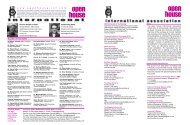Vol :37 Issue No.1 2012 - Open House International
Vol :37 Issue No.1 2012 - Open House International
Vol :37 Issue No.1 2012 - Open House International
Create successful ePaper yourself
Turn your PDF publications into a flip-book with our unique Google optimized e-Paper software.
cases, have been exclusively occupied with functional<br />
issues, architectural features and/or energy<br />
conservation. Just to mention a few examples: 930<br />
Poydras Residential Tower, Louisiana, New Orleans,<br />
USA (Minner 2010), Residential Glass Tower, Los<br />
Angeles, USA (World Architecture News 2008) and<br />
Turning Torso Residential Tower, Malmö (Design<br />
Build Network 2010). Furthermore, the mainstream<br />
international research about high-rise residential<br />
buildings is currently focusing on environmental<br />
sustainability, with little concern about the community<br />
social and cultural aspects (see for example:<br />
Niu 2004, Lai and Yik 2009, Baldwin et al 2008,<br />
Guertler and Smith 2006). Wener and Carmalt<br />
(2006) add that there is limited research on human<br />
behavioral and social responses to issues of sustainability<br />
in buildings in general, and even less so<br />
for high-rise buildings.<br />
Led by multinational property development<br />
firms such as Emmar, Al Dar and Nakheel, the UAE<br />
has witnessed accelerated development of high-rise<br />
residential buildings, albeit with a slower pace after<br />
the world economic crises in 2008. The shortage in<br />
the number of housing units in the UAE which was<br />
expected to reach to 27900 units in 2010 (DED<br />
2010) increases the demand for high-rise residential<br />
buildings. This need on the one hand, and the<br />
social failure of some world examples of high-rise<br />
residential buildings coupled with the negligence of<br />
the social and cultural aspects in the contemporary<br />
designs of residential towers in the UAE, on the<br />
other hand, poses the research main question:<br />
“how can the design of high-rise residential buildings<br />
in the UAE be more community-oriented?”. In<br />
this research community is defined according to the<br />
Cambridge Dictionary (2011) as the people living<br />
in one particular area or people who are considered<br />
as a unit because of their common interests,<br />
social group or nationality. In this case, the UAE<br />
native communities living, or would live, in high-rise<br />
residential buildings are the target. Community-oriented<br />
design in this research means the design<br />
which considers the unique social, cultural, functional<br />
and environmental needs of the local community<br />
for which it is going to be applied.<br />
To tackle the research question, the research<br />
begins with a brief investigation for the reasons<br />
behind the societal failure of high-rise residential<br />
buildings in the West. Then, the research undertook<br />
a brief review of the status quo of community-relevant<br />
dimensions in the design of high-rise residential<br />
buildings in the UAE. Afterwards, the research<br />
examined some recent different design initiatives for<br />
achieving community-oriented design in this type of<br />
housing through four approaches in different parts<br />
of the world. Based on both the lessons learnt from<br />
these global initiatives and the local dimensions of<br />
housing design in the UAE, especially the fareej traditional<br />
housing pattern, a new theoretical framework<br />
that might contribute to realizing the needs of<br />
the native UAE communities is proposed. The<br />
adopted method of the research is mainly qualitative<br />
and relied on the analysis of the community-relevant<br />
issues in the design of high-rise residential<br />
buildings. Case studies were utilized, when relevant,<br />
especially in investigating the societal failure<br />
of the high-rise residential developments and the<br />
recent approaches about community-relevant<br />
aspects in the design of them.<br />
2 . COMMUNITY-RELEVA NT PROBLEMS<br />
OF THE DESIGN OF HIGH-RISE RESI-<br />
DENTIAL BU IL DINGS<br />
In general, the community-relevant problems associated<br />
with the past experience of high-rise residential<br />
developments, especially in the West, included<br />
children’s safety, crime, depersonalized living<br />
spaces and phobias (Yuen 2005). A clear example<br />
for those problems is the St. Louis's Pruitt-Igoe highrise<br />
development. Pruitt-Igoe, completed in 1956,<br />
followed the planning principles of Le Corbusier<br />
and the <strong>International</strong> Congress of Modern<br />
Architects, in keeping the grounds and the first floor<br />
free for community activity. "A river of trees" was to<br />
flow under the buildings. Each building was given<br />
communal corridors on every third floor to house a<br />
laundry, a communal room, and a garbage room<br />
that contained a garbage chute. Unfortunately, the<br />
river of trees soon became a sewer of glass and<br />
garbage. The mailboxes on the ground floor were<br />
vandalized. The corridors, lobbies, elevators and<br />
stairs were dangerous places to walk. They<br />
became covered with graffiti and littered with<br />
garbage and human waste. In 1972, after spending<br />
more than $5 million in vain to cure the problems<br />
at Pruitt-Igoe, the St. Louis Housing Authority<br />
4 9<br />
open house international <strong>Vol</strong>.<strong>37</strong> <strong>No.1</strong>, March <strong>2012</strong> A ‘Fareej-in-the-Sky’: Towards a Community-oriented Design... Khaled Galal Ahmed





